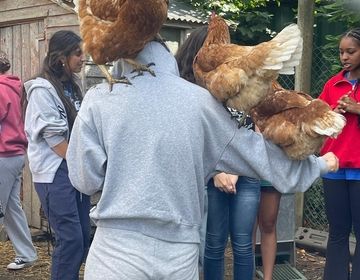Behind the Curtains of the Abbey Theatre
Dublin’s rich cultural tapestry offered an extraordinary backdrop for the CIEE Social Justice students’ latest educational adventure. Their visit to the Abbey Theatre, followed by an engaging performance of The Sugar Wife, provided a profound look into the intersection of history, art, and social justice. From exploring the theater's backstage secrets to stepping onto its storied stage, this experience was a powerful reminder of the role the arts play in societal reflection and transformation.
The adventure began in the Abbey Theatre's lobby, a space rich with history and adorned with portraits of luminaries who have shaped the theater’s legacy. As the students gazed upon the faces of W.B. Yeats and Lady Augusta Gregory, they learned about their pivotal roles in founding the Abbey. Yeats and Gregory, both visionaries, aspired to create a national theater that celebrated Irish identity and addressed pressing social issues through drama.
The tour continued into the theater's hair and costume studio, where the students witnessed the magic behind character transformation. Here, they saw the detailed artistry involved in creating authentic period looks. The studio was a treasure trove of old wigs and costumes, each piece a testament to the meticulous craftsmanship and historical accuracy that bring characters to life on stage. Students marveled at the array of wigs, from elaborate 18th-century styles to sleek modern cuts, and the costumes that spanned various eras and styles. They got to feel the texture of the wigs and the weight of many costumes. They observed how makeup techniques, even exploring how fake blood is made, could dramatically alter an actor’s appearance, adding depth and authenticity to their performance. This behind-the-scenes glimpse revealed the essential role of these elements in storytelling, enhancing the realism and emotional impact of the productions.
The climax of the tour was stepping onto the Abbey Theatre’s stage, a moment that brought history and artistry to life in a tangible way. Standing in the spotlight, the students experienced the exhilarating and daunting perspective of a performer facing the audience. The bright stage lights, the vastness of the auditorium, and the palpable sense of history created a transformative atmosphere.
Finally, the tour provided students with an overview of The Abbey Theatre's strong commitment to accessibility and community engagement. The theater offers accessible performances, including captions and audio-described shows, as well as sign language-interpreted and relaxed performances tailored for individuals with autism or sensory sensitivities. Its community engagement initiatives extend beyond the stage, featuring workshops, educational programs, and partnerships with local schools and community groups. Tickets for shows at The Abbey will never extend beyond 45 euro. These efforts aim to make theater an inclusive space where everyone, regardless of physical ability or background, can experience the transformative power of the arts.
Evening Performance: The Sugar Wife
The day concluded with The Sugar Wife, a powerful play set in 19th-century Dublin. It follows Hannah and Samuel, Quakers embroiled in the moral dilemmas of the sugar trade, alongside Sarah, an escaped slave, and Richard, an abolitionist. The play’s themes of moral conflict, social hierarchy, and racial injustice resonate strongly with the students, paralleling their studies in social justice. At the end of the performance, the students were plagued with the question, “who was good and who was evil?” According to the students, no clear answer presented itself and lively discussions ensued.
Related Posts
First Sight of the Irish Sea
In Dun Laoghaire, the students explored the Sunday market and the wide variety of food trucks. They got their first sight of the Irish Sea and had the chance to... keep reading

A Day of Baking and.... Bog Jumping?
After a week of morning classes and afternoon excursions around Dublin, the Advocating Social Justice students spent their Saturday at Causey Farm in Girley, Ireland. The day was filled with... keep reading
Investigating Ireland
The students successfully completed their first week of class! This weeks activities began with a bang when they were introduced to traditional Irish sports games, such as handball, hurling, and... keep reading
